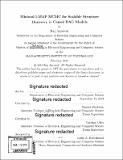| dc.contributor.advisor | Tamara Broderick and Caroline Uhler. | en_US |
| dc.contributor.author | Agrawal, Raj,S.M.Massachusetts Institute of Technology. | en_US |
| dc.contributor.other | Massachusetts Institute of Technology. Department of Electrical Engineering and Computer Science. | en_US |
| dc.date.accessioned | 2020-11-06T21:08:39Z | |
| dc.date.available | 2020-11-06T21:08:39Z | |
| dc.date.copyright | 2019 | en_US |
| dc.date.issued | 2020 | en_US |
| dc.identifier.uri | https://hdl.handle.net/1721.1/128412 | |
| dc.description | Thesis: S.M., Massachusetts Institute of Technology, Department of Electrical Engineering and Computer Science, February, 2020 | en_US |
| dc.description | Cataloged from PDF version of thesis. "February 2020." | en_US |
| dc.description | Includes bibliographical references (pages 49-51). | en_US |
| dc.description.abstract | Learning a Bayesian network (BN) from data can be useful for decision-making or discovering causal relationships. However, traditional methods often fail in modern applications, which exhibit a larger number of observed variables than data points. The resulting uncertainty about the underlying network as well as the desire to incorporate prior information recommend a Bayesian approach to learning the BN, but the highly combinatorial structure of BNs poses a striking challenge for inference. The current state-of-the-art methods such as order MCMC are faster than previous methods but prevent the use of many natural structural priors and still have running time exponential in the maximum indegree of the true directed acyclic graph (DAG) of the BN. We here propose an alternative posterior approximation based on the observation that, if we incorporate empirical conditional independence tests, we can focus on a high-probability DAG associated with each order of the vertices. We show that our method allows the desired flexibility in prior specification, removes timing dependence on the maximum indegree, and yields provably good posterior approximations; in addition, we show that it achieves superior accuracy, scalability, and sampler mixing on several datasets. | en_US |
| dc.description.statementofresponsibility | by Raj Agrawal. | en_US |
| dc.format.extent | 51 pages | en_US |
| dc.language.iso | eng | en_US |
| dc.publisher | Massachusetts Institute of Technology | en_US |
| dc.rights | MIT theses may be protected by copyright. Please reuse MIT thesis content according to the MIT Libraries Permissions Policy, which is available through the URL provided. | en_US |
| dc.rights.uri | http://dspace.mit.edu/handle/1721.1/7582 | en_US |
| dc.subject | Electrical Engineering and Computer Science. | en_US |
| dc.title | Minimal I-MAP MCMC for scalable structure discovery in causal DAG models | en_US |
| dc.title.alternative | Minimal Internet Message Access Protocol Markov chain Monte Carlo for scalable structure discovery in causal directed acyclic graph models | en_US |
| dc.type | Thesis | en_US |
| dc.description.degree | S.M. | en_US |
| dc.contributor.department | Massachusetts Institute of Technology. Department of Electrical Engineering and Computer Science | en_US |
| dc.identifier.oclc | 1203061688 | en_US |
| dc.description.collection | S.M. Massachusetts Institute of Technology, Department of Electrical Engineering and Computer Science | en_US |
| dspace.imported | 2020-11-06T21:08:38Z | en_US |
| mit.thesis.degree | Master | en_US |
| mit.thesis.department | EECS | en_US |
